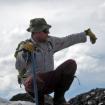
Alexander K. Stewart, USA (ret)
Support
The advent of remote-sensing technologies (e.g., LiDAR) has been vital to understanding the Earth’s landscape. The Alaskan transportation sector, for example, relies on these technologies to develop models to better understand landscape stability in Alaska (i.e., Miandad et al., 2020). These desktop models, however, require ground truthing to confirm their accuracy. Based on a model developed by Miandad et al. (2020) that combines LiDAR and Normalized Difference Vegetation Index (NDVI) to identify slope instabilities we focused on one of their “landslide susceptible” polygons located south of Glennallen, AK. Two cores were preferentially taken from tilted black spruce (Picea mariana) trees (n=57) with “a” cores taken on the down-tilted side to maximize reaction-wood data and “b” cores taken perpendicularly. Samples were prepared for microscopic analyses and were digitized and evaluated with Cybis.se programs resulting in a master chronology from 1911 to 2021 (correlation=0.505). Reaction-wood data during the last 100 years (1921-2021) averaged 12.7% of recorded widths with a maximum of 38% (2016) and a minimum of 0%. Assuming reaction wood represents slope instability, the first instability event recorded was 1934-1942 (mean 20.6%). The second major instability event recorded in the last century started in 2009 and continues with increasing reaction-wood counts (24% to 32%) to 2022 (100% as all trees were tilted). The model defines “landslide susceptible” regions as places where landslides have not occurred but are predicted to; therefore, we suggest the designation of this study site as a “susceptible” is erroneous. Likely, the model’s use of LiDAR (2011 flight) and NDVI is not sensitive enough to detect a coeval instability event, which caused approximately 25% of trees in the polygon to tilt and initiate reaction-wood growth. As a result, areas deemed “landslide susceptible” should be monitored more closely than the model may imply to protect associated infrastructure.
